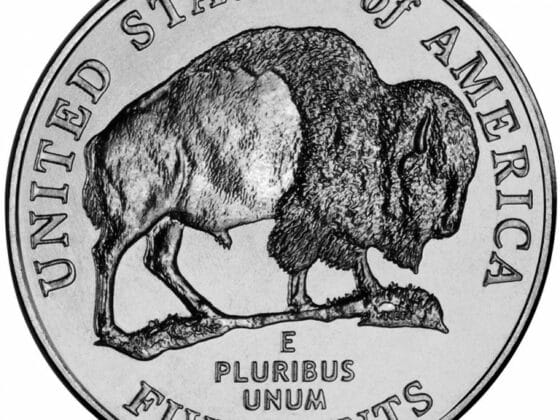1909 was the first year the Lincoln cent was minted, replacing the long-standing Indian Head penny. This new design, crafted to honor the 100th anniversary of Abraham Lincoln’s birth, bore the artistry of Victor David Brenner, a renowned sculptor and engraver. Its aesthetics would go on to captivate collectors and enthusiasts worldwide. This article explores the history, mintage, value, and rare errors of the 1909 VDB penny.
Table of Contents
The 1909 Penny Design, Composition, & Controversy
The Lincoln Cent, designed by Victor David Brenner, features a compelling and revolutionary design. Here are the main features of this magnificent coin:
Obverse Side

The obverse side of the coin prominently features a right-facing portrait of Abraham Lincoln, donning a suit, shirt, and bow tie. Surrounding the top edge, the national motto, “In God We Trust,” complements Lincoln’s likeness. To Lincoln’s immediate left, slightly above his shoulder, is the inscription “Liberty.” On the right, just beneath his chin, is the minting date “1909.”
Pennies minted in San Francisco in 1909 carry an “S” mintmark below this date. In contrast, those from the Philadelphia Mint lack a mintmark, and the Denver Mint produced none of these pennies that year.
Reverse Side
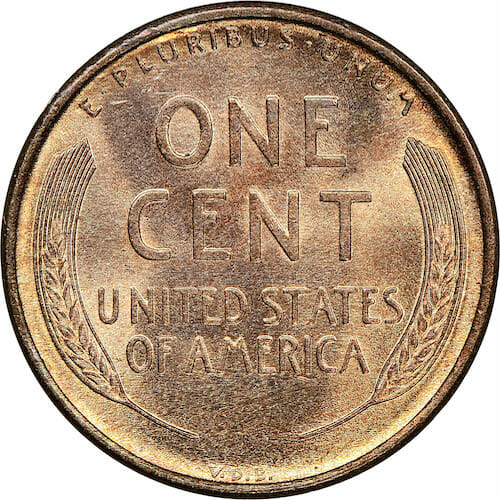
What truly sets the 1909 VDB penny apart from other Lincoln cents is the presence of Victor David Brenner’s initials, “VDB,” on the reverse side of the coin, at the bottom. This inclusion was intended to pay tribute to the coin’s talented designer, enabling the penny to gain considerable interest among collectors over the years.
Two wheat leaves are embossed on the coin’s left and right sides. The Latin phrase “E PLURIBUS UNUM” appears on the coin’s upper edge, and the denomination “ONE CENT” is struck in large font and rests in the middle between the two wheat ears. Beneath the denomination is the country’s name, “UNITED STATES OF AMERICA.”
Public Controversy
Soon after its release, the 1909 VDB penny faced public controversy. Many people found Brenner’s initials excessively conspicuous, taking away the coin’s aesthetic and historical value. The public outrage forced the U.S. Mint to remove them partway through the first year of mintage.
Despite the change, about 28 million 1909 VDB pennies with the initials intact had already been minted and were destined to become some of the most coveted pieces for collectors. So, the Lincoln pennies struck for circulation between 1909 and 1917 lacked the VDB initials. However, the U.S. Mint reintroduced the initials in 1918, which were smaller this time.
Composition and Dimensions
Constructed similarly to its forerunners, the 1909 VDB penny is made up of 95% copper and a 5% alloy of tin and zinc. It boasts a smooth perimeter, measures 19 millimeters in diameter, has a thickness of 1.4 millimeters, and tips the scale at 3.11 grams. Such specifications were largely consistent in the early iterations of the Lincoln Cent.
The hues of the 1909 VDB pennies vary from brown and red to red-brown. Those preserved in mint condition often showcase a vibrant red copper sheen, while those in circulation or subjected to the environment tend to adopt a brown or reddish-brown patina.
1909 VDB Penny Value
The 1909 VDB penny, renowned for its unique design and limited mintage, typically values at $868 in average condition. It can fetch between $1,899 to $2,332 in pristine states, with exceptional specimens auctioning for as high as $56,400. The rare 1909-S VDB variant can range from $1,100 to an impressive $175,000. Error versions of this coin further enhance its value, with some reaching $31,200 at auctions.
Limited Mintage
Due to the controversy and the subsequent decision to remove Brenner’s initials from the design, the San Francisco and Philadelphia minting facilities struck only a limited number of 1909 VDB pennies. This rarity, combined with the historical significance of these coins, makes them highly valuable and sought after by collectors.
1909 S VDB Penny
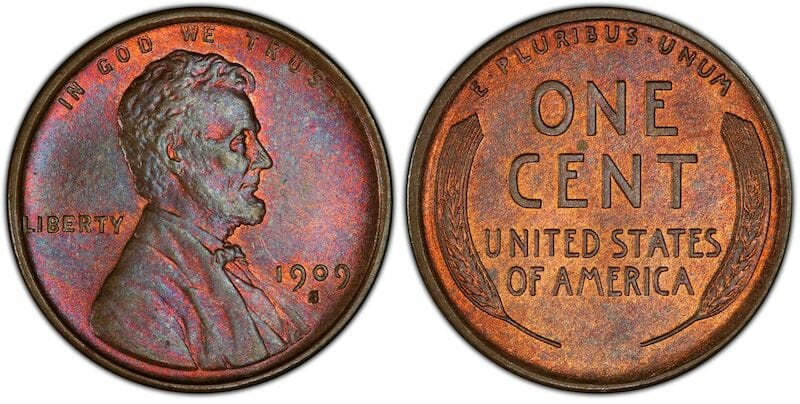
The 1909-S VDB, although not technically an error, is a rare variety. The “S” mint mark signifies its origin in San Francisco, and combined with the VDB initials on the reverse, it is one of the most sought-after U.S. coins. With its very low mintage of 484,000, it stands out as a scarce and valuable piece.
1909 S VDB Penny Value
The value of the 1909-S VDB penny is substantially higher than that of its Philadelphia-minted counterpart. The rarity of this coin makes it a prized possession for collectors, and its value reflects its limited availability.
A 1909 S VDB penny-graded VF30 is worth around $1,100, while one in AU50 can fetch $1,525. Expect to get as much as $25,000 for a 1909 S VDB penny graded MS67 BN and $57,200 or more for a red-brown specimen in mint state condition. If you have a red-coin-graded MS67, you can pocket an impressive $175,000.
1909 VDB No Mint Mark

The Philadelphia Mint produced about 27,995,000 Lincoln pennies in 1909. These pennies with no mint mark had the distinctive VDB initials on the reverse, commemorating President Abraham Lincoln’s 100th birth anniversary.
Despite their intended circulation, most coins were not used in everyday transactions. Instead, they were fervently hoarded by the public during the height of the VDB controversy, as many believed these coins held the promise of immense future value.
Today, amidst the vast array of circulated coins, the 1909 VDB penny stands out as one of the few readily available specimens in pristine, untouched condition. It is a fascinating relic of a bygone era and incredibly valuable.
1909 VDB No Mint Mark Value
A 1909 VDB brown penny-graded XF45 can fetch about $15, while one graded MS65 can be worth $375. In 2022, a brown VDB penny graded MS62 from 1909 was sold for $4,830 at an auction. One specimen graded MS68 Red Brown was sold for $22,800, while a Red VDB Penny with the same grade fetched an impressive $56,400.
Denver Mint
While the 1909 VDB penny is a standout piece in numismatics, it’s important to note that the Denver Mint did not produce any Lincoln cents in 1909. The “D” mint mark indicates Denver minting, which is only found on Lincoln cents from subsequent years.
1909 VDB Penny Error List
Collectors are particularly keen on finding rare errors in coinage, and the 1909 VDB penny does not disappoint in this regard. Here are some notable errors that make these pennies even more valuable and sought after:
1909-S Without VDB

In contrast to the 1909-S VDB, most of the pennies minted in San Francisco that year included the VDB initials. However, few coins were minted without these initials, making them a notable rarity among Lincoln cents. A 1909-S Penny Without VDB graded AU50 BN can fetch $215, while one in MS65 RD condition is worth $1,200.
Double Die Errors
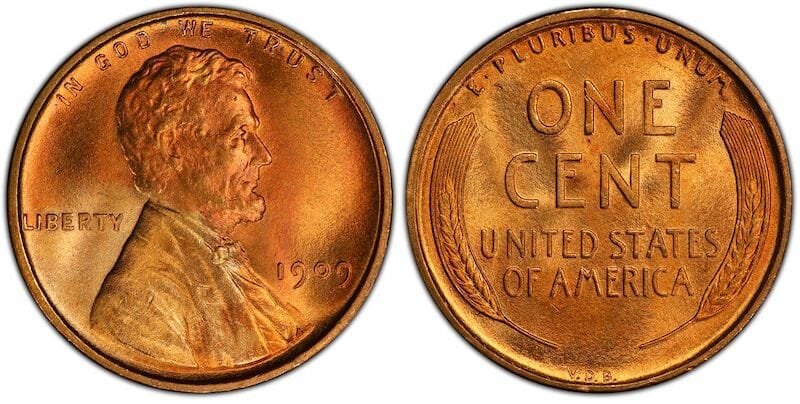
The 1909 penny had instances where the die, used to mint the coin, struck the planchet more than once, but not in perfect alignment. This resulted in the design being doubled. Double-die errors are rare and can be valuable, especially if the doubling is prominent and occurs in key areas, such as the date or Lincoln’s image. A 1909 VDB Double Die error coin graded MS67+ sold for $31,200 at Heritage Auctions in July 2023.
Off-Center Strikes

Occasionally, a 1909 penny might have been struck off-center, meaning Lincoln’s image and other details were partially off the coin. The value of off-center strikes varies based on how dramatic the misalignment is and the coin’s overall condition. Expect to spend as low as $80 for a 1909 VDB Penny with this error on platforms like eBay.
Re-punched Mint Marks (RPM)

Sometimes, a mint mark was stamped onto a die more than once but not perfectly aligned, resulting in a visible overlap of mint marks on the coin. These re-punched mint marks add a layer of complexity and uniqueness to the coin, making it more desirable to collectors. One specimen graded MS64BN by PCGS was sold for $409 at an eBay auction in 2018.
Die Breaks and Cuds
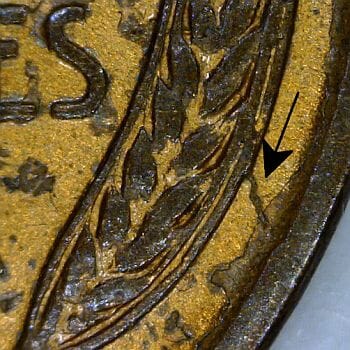
Die breaks and cuds occur when a part of the die breaks off, resulting in raised areas on the coin where the broken die no longer imprints the design. If a significant portion of the die breaks, the resulting error is called a cud. Depending on their size and location, these errors add character to the coin, enhancing its value. Such an error coin may fetch up to $331.38 on eBay.
Conclusion
The 1909 VDB penny, born amidst controversy and crafted with precision, is one of the five Lincoln cent varieties the U.S. Mint issued bearing the designer’s initials. It’s a one-cent copper coin that weighs 3.11g and has a diameter of 19 mm. The coin’s fantastic design, scarcity, and rare errors make it captivating for collectors and enthusiasts.
If you have one, consider having it authenticated by a reputable third-party grading service like PCGS, ANACS, or ANA, as it may be worth a fortune.






